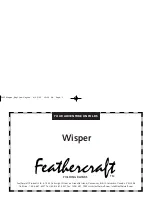
69
OPERATION
Post Operation Maintenance
Transporting The Watercraft
Do not route ropes or tie downs over the seat as they
could damage the seat. Place padding between the tie
downs and the watercraft to protect the body.
Be sure the trailer matches the watercraft’s weight and
design and that it meets trailer laws and regulations.
Using the illustrations as a reference, follow the steps
below to properly secure the watercraft for trailering.
1. Tie the watercraft
securely to the
trailer at the bow
and stern as shown
in the illustrations.
Use additional cables
if necessary. There
should be no
movement between
the watercraft and
trailer.
2. Make sure the seat
is securely latched.
We recommend the use of a Polaris watercraft cover for
protection from rocks and other debris while
transporting.
Temporary Storage
If the watercraft will be stored temporarily (less than
30 days), perform the daily maintenance procedures
beginning on page 67 and also perform the following
temporary storage procedures.
1. Block the seat (engine compartment) open about
1/2
″
(1.3 cm) to provide air circulation and to
prevent condensation from forming.
2. If the seat is saturated with water, stand it on end
(aft end down) and allow it to dry out. To avoid
damaging the seat covering, place a towel or
similar item under the seat before placing it on the
ground or floor. When dry, store the seat on the
craft as outlined in step 1.
3. Check the screen in the pump stationary nozzle for
plugging. See instructions on page 93.
4. When storing the watercraft, make sure the nose is
positioned upward at a 20
_
angle for drainage.
OR
https://www.boat-manuals.com/













































